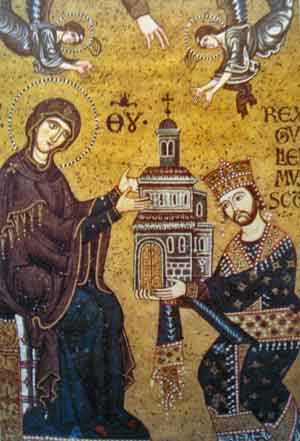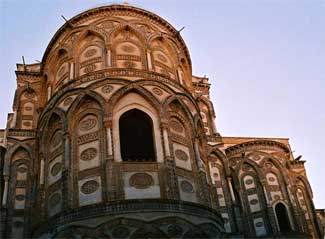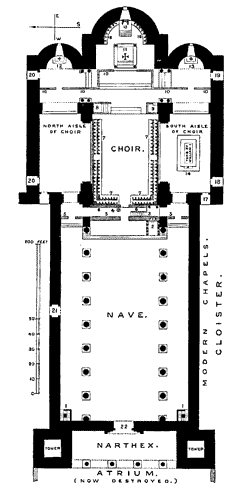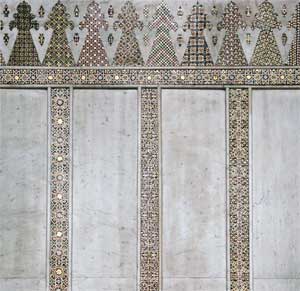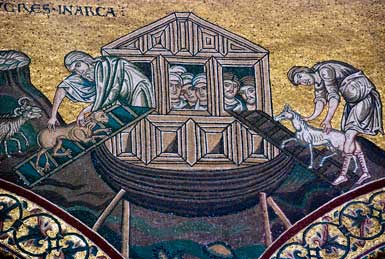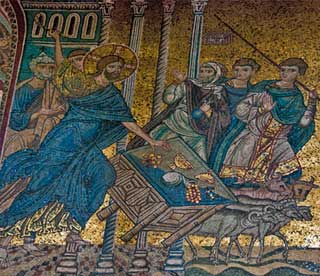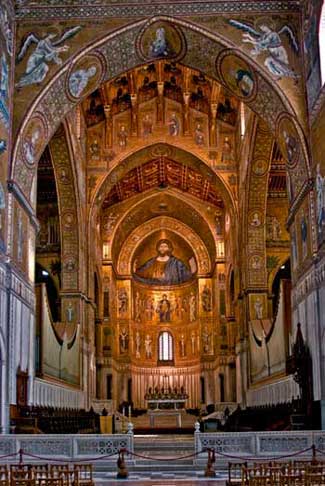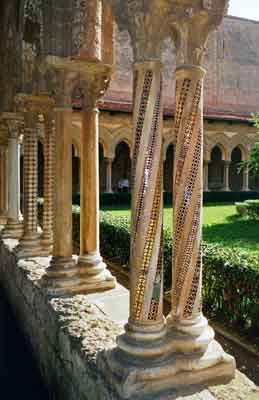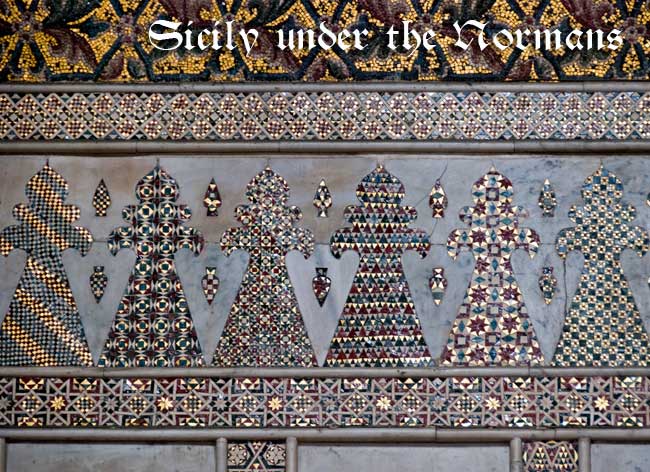
Monreale
After the Muslim capture of Palermo in AD831, the Bishop of Palermo was forced to move his seat outside what was now the capital of the new emirate. The spot he chose was high up in the hills to the southwest, on the slopes of Mount Caputo—the site of a small Arab farming village named Ba’lat. After the re-conquest, the area became a favourite hunting ground of the Norman kings and they built themselves a palace.
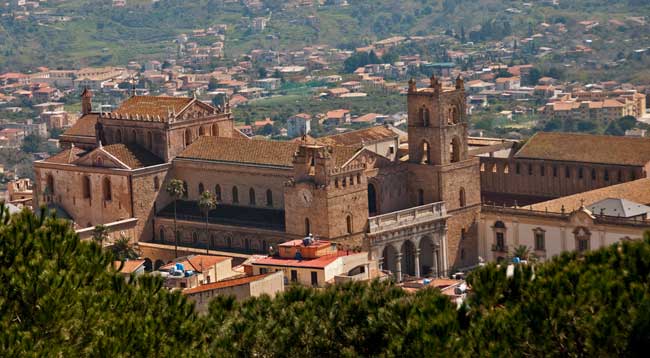
View of the Cathedral from Monte Caputo
In 1172, during the reign of William II, grandson of Roger II, construction began on a Benedictine abbey and church. The superstructure of the church, dedicated to the Assumption of the Virgin Mary, was completed by 1176 and was elevated to the rank of metropolitan cathedral by order of Pope Lucius III in 1182. As such, it was seat of the primate of the whole island. Decoration of the interior was completed by the time of the king’s death in 1189.
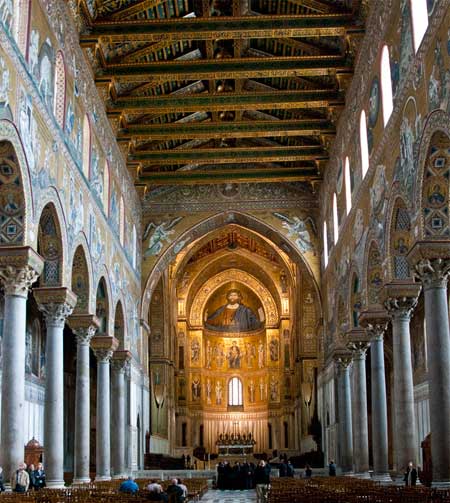
Looking down the Nave of Monreale to the Choir
Typically, the cathedral is a mixture of Roman Catholic and Greek Orthodox elements. The nave is a fairly typical Italian basilica—although it is relatively wide compared to the aisles. Two rows of rather plain columns with elaborate Corinthian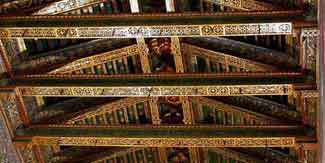 capitals separate the former from the latter. The columns support eight pointed arches above which are clerestory windows that flood the interior with light. The triple-apsed choir is very similar to examples found throughout the eastern Mediterranean world.
capitals separate the former from the latter. The columns support eight pointed arches above which are clerestory windows that flood the interior with light. The triple-apsed choir is very similar to examples found throughout the eastern Mediterranean world.
The openwork wooden ceilings (left) are low pitched and painted with bright colours. What you see today is not the original ceiling but a restored version. The original was destroyed in a disastrous fire in 1811. At the west end is the narthex (the entrance) flanked by a pair of towers. There was originally an atrium between them but this was replaced in the 16th century by a portico, which looks lovely but somewhat out of place.
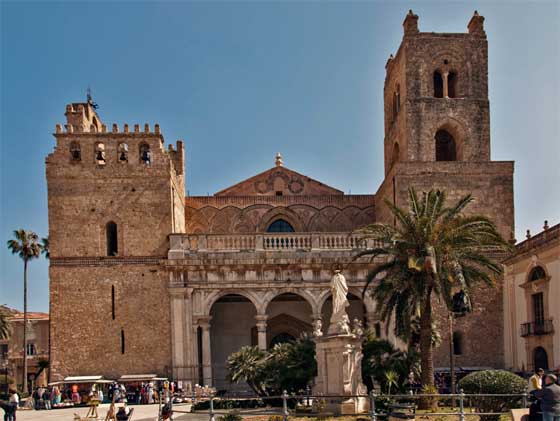
Cathedral Façade with its Renaissance portico
The interior of the cathedral contains over 6,500 square metres of mosaic decoration and cover just about all of the available wall space apart from the dadoes (the lower parts of the walls), which 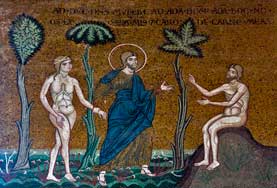 were covered with marble bordered with multi-coloured inlaid patterns (opposite right & top of the page). The the overall design and the subject matter are clearly of Byzantine origin and come straight out of the canon established by Basil II two hundred years earlier.
were covered with marble bordered with multi-coloured inlaid patterns (opposite right & top of the page). The the overall design and the subject matter are clearly of Byzantine origin and come straight out of the canon established by Basil II two hundred years earlier.
The compositions, of which there are 130 altogether, are arranged in registers, separated by bands of inlaid geometric decoration. There are as many as five such registers in parts of the choir. The themes are predominantly well-known episodes from the Bible, along with a few non-canonical events such as the coronation of William and his offering of the cathedral to the Virgin (see above). The local saint, Castrensis—a rather obscure North African clergyman who eventually became bishop of Capua—also puts in an appearance.
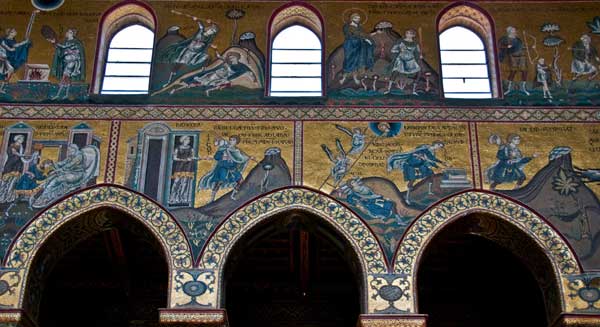
Mosaics along the north side of the nave
It is interesting that the scenes on the innermost part of the central nave are all from the Old Testament, something with which all Sicilians—Christian, Muslim or Jew—could feel at home. They are mainly derived from the Book of Genesis, starting with the Creation and ending with Jacob’s battle with the angel. Among the familiar stories shown (above) are those of Cain and Abel in the upper register and Jacob’s Ladder in the lower.
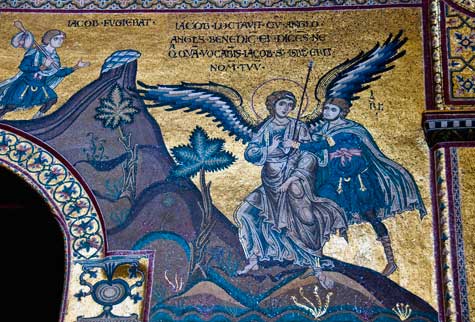
Jacob Wrestling with an Angel
Behind the colonnades on either side of the nave are scenes from the New Testament depicting the principal episodes in the life of Jesus. The stories are from the standard repertoire. There are plenty of miracles—the feeding of the multitude along with assorted healings of cripples and lepers. The compositions in the transepts and in the apses at the rear of the choir are more theological in tone, with the events of the Nativity and the Passion playing a more prominent role.
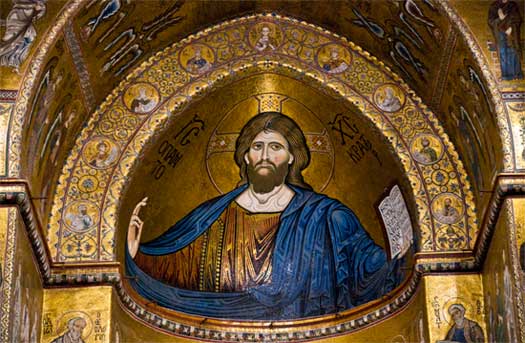
Christ Pantocrator
By far the dominating element is the figure of Christ Pantocrator (“Christ the Ruler of All”) at the rear of the main apse. The image is overwhelming, standing no less than 13 metres across and more than 7 metres high. He shown from the waist up, standing with his arms outstretched in a posture based on Classical imagery. He wears a rather sad stern look on 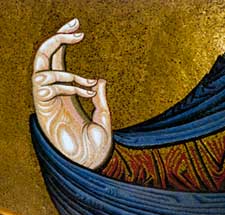 his face, with the scripture in one hand. In many examples, the other hand is raised in blessing but, in this case, the gesture is a well-known rhetorical device, conventionally used in ancient portraiture to indicate a teacher.
his face, with the scripture in one hand. In many examples, the other hand is raised in blessing but, in this case, the gesture is a well-known rhetorical device, conventionally used in ancient portraiture to indicate a teacher.
Below is the Theotokos (“Mother of God”), which depicts Mary enthroned with the infant Jesus on her lap. She is surrounded by images of the angels and various saints, including the recently martyred Thomas Becket, killed on the orders of William’s father-in-law, Henry II of England. More saints can be found, along with a number of scenes from the Gospels on the walls of the transept.The other apses have full-length portraits of Saint Peter and Saint Paul seated on their thrones.
The choir contains thrones for the archbishop and for the king, set opposite each other on either side of the main apse. Behind the royal throne is the mosaic that depicts William offering his new cathedral to the Virgin. The magnificent porphyry sarcophagus of William’s father, William I (“the Bad”), sits in the south aisle of the choir (his mother’s bones were placed in a much less impressive container nearby). His own remains were finally placed in a stone sarcophagus, erected in 1575. Both tombs were badly damaged in a fire that broke out in 1811, the same one that destroyed the ceiling and most of the other woodwork in the choir.
The Cloister
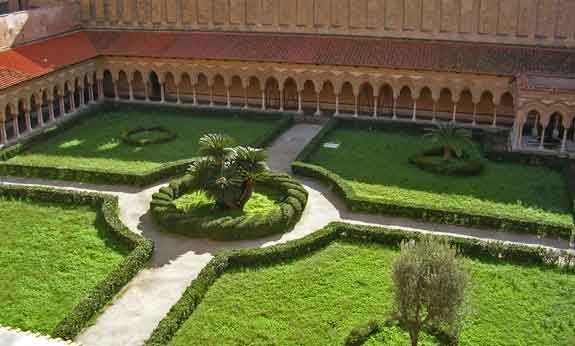
View of the Cloister at Monreals (photo from Wikimedia Commons, Giuseppe ME)
Attached to the south side of the cathedral were archiepiscopal palace and the various monastic buildings. These were once splendid structures, surrounded by a massive wall with twelve great towers. Sadly, most of this was later 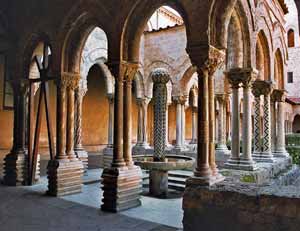 destroyed and little now remains apart from the ruins of some of the towers, most of the dormitory and, of course, the magnificent cloister.The latter was built, shortly after the completion of the cathedral, between 1174 and 1189 by workmen drawn from at least five distinct ateliers in Italy and France, each working from their own unique traditions.
destroyed and little now remains apart from the ruins of some of the towers, most of the dormitory and, of course, the magnificent cloister.The latter was built, shortly after the completion of the cathedral, between 1174 and 1189 by workmen drawn from at least five distinct ateliers in Italy and France, each working from their own unique traditions.
The cloister (Latin: claustrum= enclosure) is a perfect square, measuring approximately 47 x 47 metres, with colonnaded porticoes running along all four sides. The form is based on the colonnaded peristyle court of antiquity and was designed to provide a venue for restful contemplation by the monks, away from the hurly-burly of the outside world. Typically, for this time and place, there is a significant Islamic contribution in the shape of an Arab fountain (above left) set within its own, much smaller enclosure in the south-eastern corner.
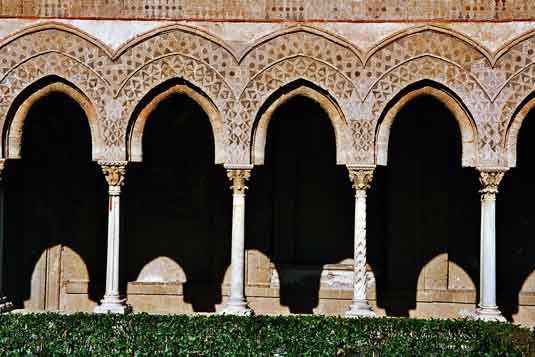
Portico of the Cloister. Photo by Bernhard J. Scheuvens
The courtyard is surrounded by columns supporting ornately carved, pointed arches. There are 25 double columns along each side and a quadruple one in each corner. Another four double columns and one quadruple column were used to enclose the fountain.
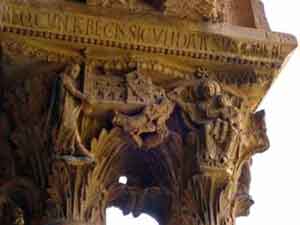
|
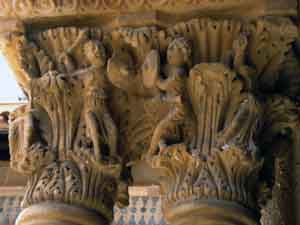
|
The columns were of white marble (they have since acquired a golden patina) and were alternately plain or decorated with patterns of gold or coloured glass tesserae. The capitals were also marble and were carved with vegetal designs as well as biblical or allegorical scenes. Prominently displayed is the figure of William offering the cathedral to the Virgin.

